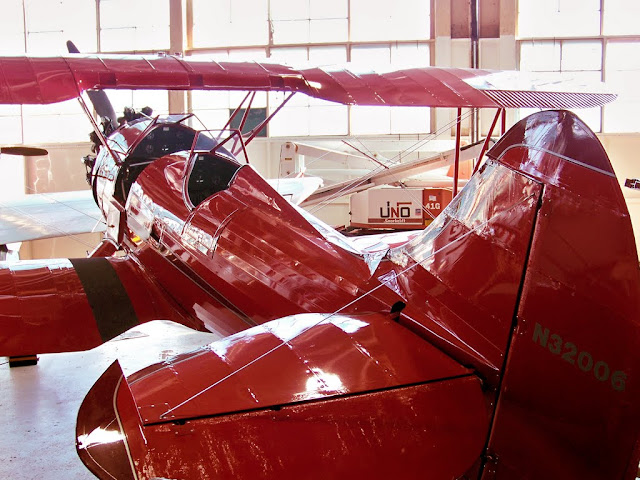| Date | Aircraft | Route of Flight | Time (hrs) | Total (hrs) |
| 19 Mar 2011 | N21481 | PTK (Waterford, MI) - JXN (Jackson, MI) - PTK | 1.5 | 910.2 |
A flurry of traffic swirled around the Jackson County Airport. At the center of the chaos stood the control tower, its sole occupant orchestrating the arrivals and departures of all aircraft. A virtuoso conductor, standing atop a glass-enclosed podium, directed an orchestra of aircraft arrayed on an aerial stage several miles across.
The frequency crackled with crisp directives beaming forth. Call-response, call-response.
Of course, the harmony developed by this maestro was not audible on the half-duplex frequency; all participants, by definition, were soloists. Harmony existed in the weaving of disparate flight paths safely to and from the airport.
So it was when Greg and I first tuned the Jackson tower frequency from 20 miles away; brisk call-response, give and take, between aviators and controller.
"Jackson tower, Piper 123, 13 miles east, landing, kilo."
"Piper 123, report over downtown Jackson, right base runway 32."
And then, a change in tempo. A new soloist, uncertain, tremulous voice reaching out across the airwaves. "Ummm...Jackson tower...Cessna 123, six miles...ummm...can I get vectors to the airport?"
The controller immediately slowed his rapid speech. "Cessna 123, Jackson tower, where are you?"
"Ummm....my GPS says six miles away."
"Cessna 123, can you see I-94? Are you north or south of it?" The controller's voice floated gently with patient warmth.
"Ummm...yes...I'm north," responded the anxious pilot.
The controller matter-of-factly resumed his brisk tempo for a moment to work two other airplanes.
Then he slowed again. "Cessna 123, I think I see you. I want you to cross I-94 and turn west."
Once Cessna 123 acknowledged, the Piper pilot chimed in, "Piper 123 has the Cessna off our right wing."
"Cessna 123, do you see the Piper ahead of you?" queried the controller.
"Ummm...yes."
"Ok, Cessna 123, I want you to follow him to the airport."
"Ok, thank you," stammered the pilot of Cessna 123. "Sorry...sorry...I'm so sorry..."
His voice ringing with paternal kindness, the controller responded. "No problem. On my first solo cross country, they had to divert airplanes in Bravo airspace because of me."
Then, a return to brisk communication to manage the business at hand.
"Piper 123, clear to land 32."
"Clear to land 32, Piper 123."
"He's good," I commented to Greg about the controller. With the drama winding down, it seemed safe to join the symphony without disrupting the exchange between Jackson and Cessna 123. "Warrior 21481, 10 east, landing, kilo."
"Warrior 481, report over downtown Jackson, enter right base runway 32."
"Right base 32, report over Jackson, Warrior 481."
Greg and I entered Jackson's Delta airspace as multiple aircraft took off and landed on runways 32 and 6 under the benevolent eye of the controller. The nervous pilot of Cessna 123 landed, taxied to the end of the runway, and launched again. I can only assume that he was a solo student on a cross country flight. And, like the controller, I recalled my own foibles with air traffic control when I reached that particular milestone ("
Mishaps at Muskegon").
In the landing flare, we overheard the controller talking to a jet that just departed runway 6 prior to our touchdown on 32. "Want to do a low pass on 6? I haven't seen one of those Czech birds in a long time."
Once the other pilot accepted, we were given a clearance to taxi toward the ramp, but to hold short of runway 6. I repeated the clearance and, moments later, we rolled to a stop at the hold line.
To our right, a blue and white L39 Albatros, a Czech-built military trainer, rolled onto a high final approach. He streaked over the runway directly in front of us, smoke on, then pulled into a steep vertical climb at the airport boundary.
Moments later, as though nothing had happened, the controller was back on frequency with a nonchalant, "Warrior 481, cross runway 6-24 and taxi to the ramp." We arrived at the ramp, found a spot to park, and shut down, thus ending our part in the masterful symphony conducted by the tower controller.
 |
| Landing on Jackson's Runway 6 with Dave in the Decathlon, April 13, 2003 |
When I still lived in Michigan, Jackson was my favorite $100 hamburger destination. My last visit there was September 11, 2004.
I tried to visit in 2005, but turned away from Jackson when radio broadcasts from the tower made it clear that breakfast would be a long wait. As a result, I was excited to return to Jackson with one of my oldest and dearest friends riding right seat in Warrior 481.
Climbing out of the Warrior, we were met on the ramp by the elderly owner of a silver Ercoupe parked next to us. He looked Warrior 481 over with a keen eye.
"Is that your Cherokee?" At my affirmative response, he nodded. "Good airplanes. Owned a lot of Cherokees over the years. That's a nice looking one. I'm based out of Monroe, where are you out of?"
"Rochester, New York," I answered. His face registered mild surprise.
"Did you say, 'New York'?".
"Yup, but for this weekend, Pontiac." He nodded sagely. He was momentarily distracted by two others lingering near the Ercoupe's wingtip. In his best
'Hey, you kids!' voice, he bellowed at them, "Don't touch that airplane!" Greg and I exchanged looks; it was our turn to register surprise.
"Oh, it's OK, they're friends of mine," the old timer explained mildly. The other two approached, easily a decade younger than the Ercoupe pilot. Upon their arrival, our new friend changed topic. "You know, I think age is all about mental acuity and physical condition. Don't you?"
 |
| The ramp at Jackson as seen on my first visit, April 13, 2003 |
Greg and I allowed that he had an excellent point. With our agreement secured, he looked shrewdly at his friends. "See? They agree. And I'm in much better shape than either of you two." The taller of the pair flexed a bicep to refute this judgment.
"Oh, that's nothin'," countered the Ercoupe pilot. "Here's a real muscle." And he did something that neither Greg nor I had ever seen before. He showed us the back of his hand and flexed the muscle at the base of his thumb. A comparatively enormous muscle rose from his withered hand.
I looked at Greg. Greg looked at me. The word "tumor" began to unfurl in my mind, but before the thought took hold, the Ercoupe pilot spoke again. "It's a molar muscle." Then he stared at me for a moment, waiting.
Click.
"You're a dentist," I realized out loud.
"Well, retired, but yes. That's what a few decades of pulling molars will give you. By the way, you guys have great teeth." We chatted for a few more minutes about airplanes before shaking hands and parting company.
Entering the terminal, I shook my head and muttered "molar muscle" under my breath as Greg chuckled in response.
 |
| Greg with Warrior 481 at Jackson |
We spent a leisurely time eating our lunch at the Airport Restaurant, talking and watching airplanes come and go through the large picture windows separating us from the ramp. While we ate, the ramp slowly emptied as the lunch crowd returned to the clear blue sky.
When our lunch was finished and the waitress failed to pique our interest in dessert, we returned to Warrior 481 and took part in the symphony once again.
Somewhere out there flew a fledgling pilot who would likely look back on this day in gratitude for the benevolent maestro who guided him safely to port.



















